Figure 2. Transient and reversible effects of H2O2 on myofibrillar contractile function .

Original [Ca2+]i and force records from submaximal (50 Hz) contractions of single FDB muscle fibres exposed to H2O2 (300 μm) for up to 8 min (A) and H2O2 for 6 min followed by exposure to the reducing agent DTT (1 mm) for 10 min (B). Note that H2O2 causes major force changes whereas [Ca2+]i is little affected, which means that H2O2 mainly acts at the myofibrillar level. The effects on force are time dependent with brief H2O2 exposure resulting in increased submaximal force, which is followed by a progressive force decline (A). Furthermore, the force depression caused by prolonged H2O2 exposure is reversed by reduction with DTT (B). Conversely, prolonged exposure to DTT results in depressed submaximal force that can be reversed by application of H2O2 (not shown). Figure adapted from Andrade et al. (1998).
